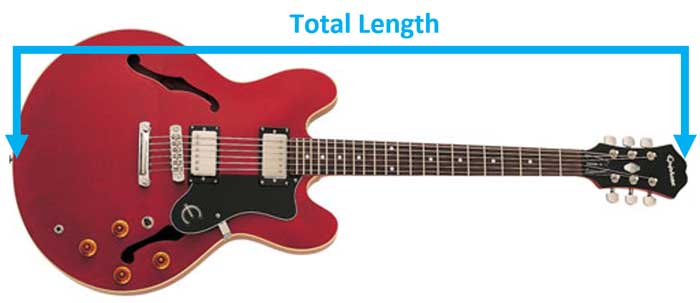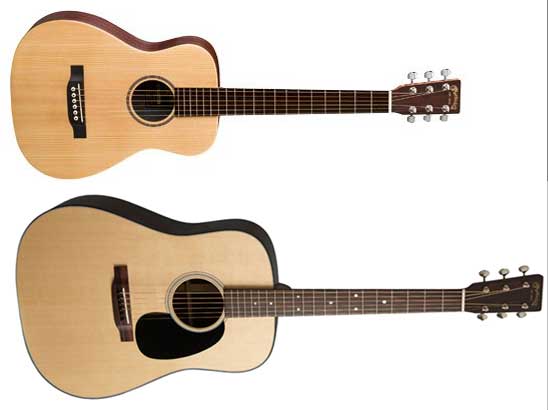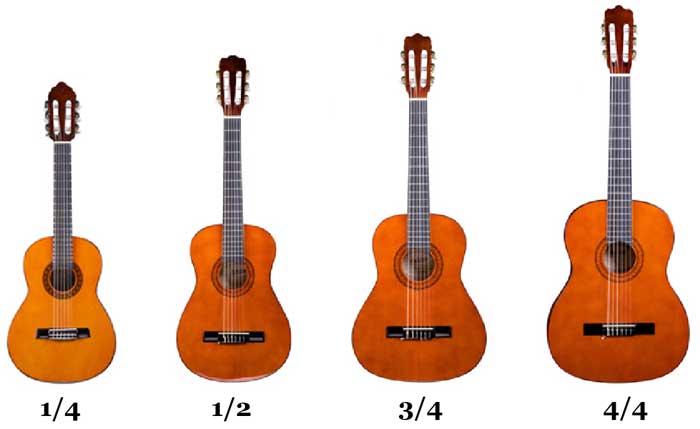Guitars come in different sizes and the size of your guitar has a big impact on playability. If you’ve ever seen a young child struggle to play a full-sized guitar, it should be clear why matching the right size guitar to each person is important.
In this guide, I’ll answer some of the most common questions about guitar sizes. You’ll be able to use this information to choose the best-sized guitar for your needs or to find the right size case for your guitar.
After reading this guide, have a read through my guide on How Much Electric Guitars Weigh as it’s also a good idea to understand how much guitars can vary in weight. Quite often the size of a guitar doesn’t give an accurate idea of how heavy the guitar is.
If you want to learn guitar, check out the 8 Step to Learn Guitar here. The guide will take you from knowing nothing about guitar to playing your first full song.
How to Measure a Guitar
Let’s first look at how to measure a guitar. Knowing how to measure guitars is important so you can accurately compare different guitar sizes.
There are two main ways you can measure a guitar. The first way is to measure the total length of the guitar from end to end. The second way is to measure something called the scale length.
While knowing the total length is handy, knowing the scale length is far more important.
Before we look at how to measure a guitar, it’s important to know about the different parts to measure.
Here is a quick diagram showing the main parts of the guitar:

There are three main parts of every guitar as highlighted above:
- The headstock (highlighted in green)
- The neck (highlighted in red)
- The body (highlighted in blue)
Whether you buy an acoustic guitar or an electric guitar, it will have these three parts. The only exception is an uncommon type of electric guitar that doesn’t have a headstock (these are called headless guitars).
To learn more about the parts on acoustic and electric guitars, read through this guide for diagrams and examples of different types of parts across different brands.
Measuring a Guitar’s Total Length
When we measure the total length of a guitar, we measure from the top of the headstock to the bottom of the body as shown below:

Take a tape measure and line it up along the strings. The total length is from the very end of the body to the tip of the headstock.
If you take a look at the earlier photo of the different types of guitars, you’ll notice that every type of guitar has a different shaped body. For this reason, you will see wildly different measurements for total length.
The total length of a ‘full size’ guitar could be anywhere from 36 inches to well over 40 inches. There is no standard total length for guitar because there are many different types of guitars.
The total length of a guitar isn’t a good way to compare guitars. Some brands have long headstocks, while other brands have short headstocks. The size of a headstock doesn’t make a guitar feel any different when you play it, but differences in headstocks will throw off measurements.
I don’t recommend comparing guitars based on total length. Unless you’re comparing apples with apples, you won’t learn much from the total length of a guitar.
Measuring a Guitar’s Scale Length
A better measurement is by looking at the scale length of a guitar.
The scale length is the most important measure for a guitar because it impacts how a guitar feels when you play it. Even a small difference in scale length can feel completely different when playing.
You measure a guitar’s scale length by measuring from the bridge to the guitar’s nut as shown in the below diagram:

To see examples of different scale length measurements, what scale lengths different brands use, and why it matters, read through this guide on scale length. You might be surprised by how scale length can completely change how a guitar feels to play.
What is the size of a ‘full size’ guitar?
The term ‘full size’ guitars can cause some confusion as each type of guitar (eg: classical, dreadnought, fender, Les Paul, etc.) has a different size considered standard. Each brand may build their guitars at a slightly different size.
A typical full-size guitar is around 38 inches long (96.5cm) with a scale length of around 25.5 inches (64.8cm). This varies widely across brands and guitar types.
If you have a guitar and you want to find out whether it is a full-size guitar, the first thing to check is the scale length. If the scale length is around 25 inches or higher (63 cm), it’s likely to be a full-size guitar.
Even if the total length is far longer or shorter than 38 inches, if the scale length is around 25 inches or higher, it’s a full-sized guitar.
If the scale length is far below this range (eg: 20 inches or 50 cm), it is likely to be a scaled-down guitar such as a 3/4 guitar. There are many different types of scaled-down guitars used for different purposes.
Some scaled-down guitars are designed as travel guitars. The smaller length makes it easier to transport. Other scaled-down guitars are designed for people with small hands or for children. These scaled-down guitars feel very different from a typical full-sized guitar.
The below photo compares a travel guitar against a full-sized dreadnought acoustic guitar:

As you can see, not only does the travel guitar have a shorter total length, but the scale length is also shorter. Some travel guitars cut the total length down while keeping a full-sized scale length, while others cut both total length and scale length down.
The important point here is that there is no standard size for “full size” guitars. A dreadnought acoustic guitar and a Les Paul electric guitar are both full-size guitars, but they both have different scale lengths, different total lengths, and feel very different to play.
What are the different sizes of guitars?
As there are so many different sizes when it comes to guitars, let’s have a look at some of the most common sizes. Knowing the typical size of different types of guitars can help you figure out what is right for you.
While there are many variations of sizes for acoustic guitars, the most common system contains four sizes:

The 4/4 guitar shown above is a full-sized classical guitar. The other three guitars are scaled down versions.
While you would expect a 1/2 size guitar to be half the size of a full-sized guitar, you can clearly see in the above photo that isn’t the case. The naming system used with acoustic guitars can be very misleading.
A 1/4 guitar isn’t really a quarter in size compared to a full-sized guitar. A typical 1/4 scale guitar has a scale length of 19 inches (48 cm) and a total length of around 31 inches (78 cm). A 3/4 sized guitar is really around 7/8 in size compared to a full-sized guitar.
The point to remember here is that the names are just trying to simplify the different options. They don’t actually match the size of the guitars.
What size guitar does a child need?
The size of a guitar makes a huge difference to a child. A full-sized dreadnought acoustic guitar can be impossible for a small child to play. The massive bodies of acoustic guitars can be overwhelming for a young child.
The younger a child is, the smaller the guitar needs to be to be able to comfortably play. 1/2 and 3/4 sized guitars are commonly used for children as they’re far easier to play. The scaled down size means a young child can reach over the body and comfortably reach the fretboard.
Here are some general rules-of-thumb on what size guitar to get for children:
- 1/4 sized or ukulele: up to 5 years old
- 1/2 sized: 5-7 years old
- 3/4 sized: 7-10 years old
- Full sized: 10 years and older
The above recommendations are quite different from typical advice you see on other websites. As I’ll explain below, I recommend buying a guitar a bit bigger than what you think you should get.
Important: think of buying a guitar like buying a pair of shoes for your child. Children grow rapidly and something that looks like a perfect fit today can quickly become too small. When buying shoes for a child, it’s a best practice to buy something bigger than needed. While it might not be a perfect fit today, it ensures your child won’t immediately grow out of their shoes.
It’s the same with buying a guitar. If you were to buy the ‘perfect’ size guitar for your child today, in 6-12 months you may find that it starts to feel a bit small to your child.
Buy a guitar in the same way you would buy a pair of shoes for your child. It’s okay if the guitar is a bit too big in the beginning because your child will quickly grow into it.
Should you buy a full-sized guitar for your child?
While it makes perfect sense to buy a scaled-down guitar for a child, that isn’t the only option. The other option is to buy a full-sized guitar.
Some guitar teachers will insist that larger guitars will impede a child’s progress. Other teachers will tell you that children can effectively learn on larger guitars.
The benefit of buying a full-sized guitar for your child is that they won’t ever grow out of it. That means you won’t need to re-buy a guitar in the future and your child will potentially use their first guitar for life.
Full-sized guitars also sound far better than scaled-down guitars. 1/4 or 1/2 sized guitars sound quite dull and as your child develops their ear, they may lose inspiration due to a dull-sounding guitar.
The below video shows that small children can effectively learn on full-sized guitars:
Make no mistake, the above girl has incredible discipline, but if a 9-year-old girl is able to play a full-sized guitar, others can too.
I wouldn’t recommend a full-sized guitar for children under around 7, so if your child is around 7 or older, consider a full-sized electric guitar.
With acoustic guitars, you need to be more cautious that the guitar isn’t going to be too big for your child. A full-sized dreadnought guitar (steel string acoustic) has a huge body that can be a major obstacle for a small child.
Classical acoustic guitars are more manageable, but they still have a fairly large body. If your child wants to learn on an acoustic guitar, you may want to avoid getting a full-sized guitar until your child is around 10-11.
I started learning guitar at the age of 7 on a full-sized electric guitar. Looking back at photos I can see that it was too big for me at the time, but I have no memory of feeling frustrated with the size of the guitar.
I still play guitar today, so the large guitar wasn’t enough to stop me.
I’m glad I started on a full-sized guitar as I still have it today and regularly play on it. That guitar is extra special to me because it’s my first guitar and I still enjoy playing it.
If I started on a 1/2 sized guitar, there’s no way I would still play it today.
The downside of starting a child on a full-sized guitar is that they may not be able to deal with the larger size. If the guitar is too big for the child to manage, it can frustrate them and they may give up learning the guitar.
So while there are benefits to starting on a full-sized guitar, you need to use your judgment on whether your child will be able to manage with the size or not.
One other point to consider is that a scaled-down guitar doesn’t guarantee that your child will stick with guitar. While it may make things easier, it doesn’t guarantee success.
If you’re considering getting guitar lessons for your child, have a read of this guide to see how the age of your child affects the type and quality of lessons they will receive. Knowing what age kids can start learning guitar can help you set realistic expectations.
To learn more about guitar sizes, read through my guide on Guitar Scale Length here. If you’ve ever wondered why different types of guitars feel so different to play, read my guide on guitar scale length for answers.
